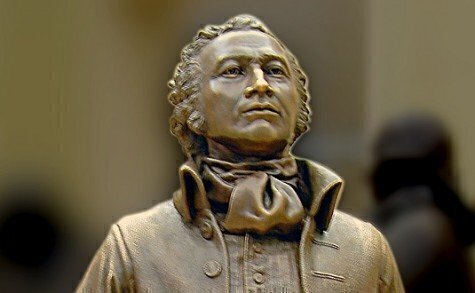On this day in 1789, George Washington signed into law the act that created the Treasury Department. The move became crucial to America’s survival, but it also created a constitutional debate about federal powers that remains with us today.
 The Founders knew that government under the new Constitution had to stabilize the shaky financial foundations of a new nation that struggled with debts incurred during and after the break from Great Britain. In July 1789, Congress approved a bill establishing a Treasury Department and sent it to President George Washington for consideration.
The Founders knew that government under the new Constitution had to stabilize the shaky financial foundations of a new nation that struggled with debts incurred during and after the break from Great Britain. In July 1789, Congress approved a bill establishing a Treasury Department and sent it to President George Washington for consideration.
At first, President Washington offered the Secretary of the Treasury job to Robert Morris, who was known as the “financier of the Revolution” and had led a predecessor department during the pre-Constitution era. Morris declined but recommended that Washington turn to Alexander Hamilton for the critical position. (Morris and Hamilton had similar visions of a national bank that would become a point of political debate for generations.)
On September 2, 1789, Washington signed a Treasury Act that said “there shall be a Department of Treasury, in which shall be the following officers, namely: a Secretary of the Treasury, to be deemed head of the department; a Comptroller, an Auditor, a Treasurer, a Register, and an Assistant to the Secretary of the Treasury, which assistant shall be appointed by the said Secretary.” It immediately became the biggest department in the executive branch, with 39 employees.
Hamilton became Treasury Secretary on September 11, 1789, and shortly after, Hamilton’s vision of a central banking system that supported manufacturing, as well as agriculture, met with equally strong opposition from Thomas Jefferson, James Madison, and Edmund Randolph.
Hamilton presented this vision in a January 1790 treatise called “Report Relative to a Provision for the Support of Public Credit.” The report to Congress detailed Hamilton’s argument that a coordinated system of central federal credit and debt was needed for the nation’s survival.
In December 1787, Hamilton had also argued in The Federalist No. 30 that a central economic system with managed debt was critical to the United States’ ability to undertake commerce. (Hamilton had first argued for a national bank in 1779 at the age of 24.)
“The power of creating new funds upon new objects of taxation by its own authority would enable the national government to borrow, as far as its necessities might require. Foreigners as well as the citizens of America, could then reasonably repose confidence in its engagements,” Hamilton wrote.
The 1790 report offered several controversial proposals. First, Hamilton wanted the Treasury Department to redeem federal debt on generous financial terms. He also proposed that the federal government assumed debt incurred by the states and that they become equal partners in the federal debt. Hamilton also wrote that “the Secretary contemplates the application of this money, through the medium of a national bank, for which, with the permission of the House, he will submit a plan in the course of the session.”
The final proposal about a national bank met with immediate objections from Madison and Jefferson as falling outside the bounds of the Constitution. Madison believed it was clear that the Constitution intended for the states to charter and run their own banking systems.
Hamilton’s proposal was “a broad construction of federal powers … [that would deliver] a powerful blow at the barriers against an indefinite expansion of federal authority,” Madison argued on the House floor.
Madison insisted that Hamilton wanted to use the government to establish the national bank as a corporation – a power that fell outside of Article 1, Section 8, as a power granted directly to Congress. Attorney General Randolph told President Washington that he agreed with Madison’s reasoning.
Jefferson also urged Washington to veto a proposed bill to establish a national bank. He used many of the same arguments made by Madison, arguing that a strict reading of the Constitution made it clear that establishing a national bank fell outside the bounds of the Necessary and Proper Clause.
Washington, in turn, asked Hamilton to respond to these arguments. Hamilton’s lengthy reply, written in one evening, supported the idea of implied powers granted by the Constitution.
In his “Opinion on the Constitutionality of an Act to Establish a Bank,” Hamilton made an argument that the Constitution implied that Congress could take necessary actions to meet national goals, regardless of whether these measures were explicitly stated in the Constitution
“It leaves therefore a criterion of what is constitutional, and of what is not so. This criterion is the end, to which the measure relates as a mean,” he argued. “If the end be clearly comprehended within any of the specified powers, and if the measure [has] an obvious relation to that end, and is not forbidden by any particular provision of the Constitution—it may safely be deemed to come within the compass of the national authority.”
Washington agreed with Hamilton and thus declined to veto the bill that proposed the First Bank of the United States. The bank became a reality in 1791, but the debate over these core constitutional concepts remains strong today.
In the subsequent years of Hamilton’s time as Treasury Secretary, the American economy stabilized, but the philosophical rift between Hamilton’s Federalist allies and the Jefferson-Madison faction grew into the first version of partisan politics that we all know well today. Hamilton resigned as Treasury Secretary in 1795.
Scott Bomboy is the editor in chief of the National Constitution Center.







